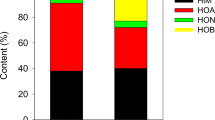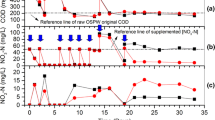Abstract
With high organics and ammonia, leachate from waste transfer stations (WTSs) is among the most complex wastewater that cannot be easily disposed by signal biological processes. In this study, an electro-dissolved ozone flotation (E-DOF) was established, in which dissolved ozone flotation (DOF) and electro-coagulation (EC) occurred concurrently in one unit and integrated with anoxic/oxic membrane bioreactor (A/O-MBR) to dispose leachate from a WTS. In the integrated reactor, E-DOF acted as pretreatment and advanced treatment unit. A/O-MBR acted as secondary treatment unit. The E-DOF pretreatment achieved 34.48% COD and 16.96% NH3-N removal efficiency through synergistic effect between EC and DOF. BOD5/COD of leachate was increased from 0.32 to 0.51 after E-DOF pretreatment, indicating the enhancement of biodegradability. Molecular weight distribution (MWD) and three-dimensional excitation-emission matrix (3D-EEM) analysis demonstrate that the reduction of molecular weight and elimination of refractory organics through EC, ozone, and their interacted product (•OH) are attributed to biodegradability enhancement in lechate. Microbial community analysis proved that chemoheterotrophy and oxic chemoheterotrophy functions, mainly provided by Truepera, Aquamicrobium, Saprospiraceae, and Lentimicrobiaceae, ensured the efficient degradation of organic in the secondary processes. E-DOF advanced treatment effectively disposed residual contaminant in MBR effluent. The E-DOF advanced treatment mainly disposed residual contaminant in MBR effluent. High removal efficiency of COD (98.59 ± 0.27%), NH3-N (95.59 ± 0.50%), TN (95.37 ± 0.73%), and TP (96.75 ± 1.66%) were observed in the integrated reactor, and final effluent met the discharge standards for inclusion in the sewage pipe network in China.








Similar content being viewed by others
Availability of data and materials
All data generated or analyzed during this study are included in this published article (and its supplementary information files).
References
Asaithambi P, Sajjadi B, Abdul Aziz AR, Daud WMABW (2017) Ozone (O3) and sono (US) based advanced oxidation processes for the removal of color, COD and determination of electrical energy from landfill leachate. Sep Purif Technol 172:442–449
Ayiania M, Carbajal-Gamarra FM, Garcia-Perez T, Frear C, Suliman W, Garcia-Perez M (2019) Production and characterization of H2S and PO43− carbonaceous adsorbents from anaerobic digested fibers. Biomass Bioenergy 120:339–349
Aziz SQ, Aziz HA, Yusoff MS, Bashir MJK, Umar M (2010) Leachate characterization in semi-aerobic and anaerobic sanitary landfills: a comparative study. J Environ Manage 91(12):2608–2614
Chen M, Zhang X, Wang Z, Wang L, Wu Z (2017) QAC modified PVDF membranes: antibiofouling performance, mechanisms, and effects on microbial communities in an MBR treating municipal wastewater. Water Res 120:256–264
Chiang PC, Chang EE, Liang CH (2002) NOM characteristics and treatabilities of ozonation processes. Chemosphere 46(6):929–936
Chys M, Oloibiri VA, Audenaert WTM, Demeestere K, Van Hulle SWH (2015) Ozonation of biologically treated landfill leachate: efficiency and insights in organic conversions. Chem Eng J 277:104–111
Coimbra ECL, Mounteer AH, Coimbra ECL, Mounteer AH, do Carmo ALV, Michielsen MJF, Tótola LA, Guerino JPF, Gonçalves JGAN, da Silva PR (2021) Electrocoagulation of kraft pulp bleaching filtrates to improve biotreatability. Process Saf Environ Prot 147:346–355
Deng S, Jothinathan L, Cai Q, Li R, Wu M, Ong SL, Hu J (2021) FeOx@GAC catalyzed microbubble ozonation coupled with biological process for industrial phenolic wastewater treatment: catalytic performance, biological process screening and microbial characteristics. Water Res 190:116687
El-Ghenymy A, Alshayab M, Khodary A, Sirés I, Abdel-Wahab A (2019) Corrosion behavior of pure titanium anodes in saline medium and their performance for humic acid removal by electrocoagulation. Chemosphere 246:125674
Fernandes A, Pacheco MJ, Ciríaco L, Lopes A (2015) Review on the electrochemical processes for the treatment of sanitary landfill leachates: present and future. Appl Catal B 176–177:183–200
Haag WR, Hoigné J, Bader H (1984) Improved ammonia oxidation by ozone in the presence of bromide ion during water treatment. Water Res 18(9):1125–1128
Hui WA, Dg A, Zc A, Nza B, Hy A, Zlab C (n.d.) Improved understanding of dissolved organic matter transformation in concentrated leachate induced by hydroxyl radicals and reactive chlorine species - ScienceDirect. J Hazard Mater 387:121702
Ingelsson M, Yasri N, Roberts EPL (2020) Electrode passivation, faradaic efficiency, and performance enhancement strategies in electrocoagulation—a review. Water Res 187:116433
Jeon Y, Li L, Calvillo J, Ryu H, Santo Domingo JW, Choi O, Brown J, Seo Y (2020) Impact of algal organic matter on the performance, cyanotoxin removal, and biofilms of biologically-active filtration systems. Water Res 184:116120
Jin X, Jin P, Hou R, Yang L, Wang XC (2017) Enhanced WWTP effluent organic matter removal in hybrid ozonation-coagulation (HOC) process catalyzed by Al-based coagulant. J Hazard Mater 327:216–224
Jin X, Xie X, Liu Y, Wang Y, Wang R, Jin P, Yang C, Shi X, Wang XC, Xu H (2020) The role of synergistic effects between ozone and coagulants (SOC) in the electro-hybrid ozonation-coagulation process. Water Res 177:115800
Jin X, Xie X, Zhang S, Yang C, Xu L, Shi X, Jin P, Wang XC (2021) Insights into the electro-hybrid ozonation-coagulation process: significance of connection configurations and electrode types. Water Res 204:117600
Liu J, Zheng G (2020) Emission of volatile organic compounds from a small-scale municipal solid waste transfer station: ozone-formation potential and health risk assessment. Waste Manage 106:193–202
Liu T, Chen Z-L, Yu W-Z, You S-J (2011) Characterization of organic membrane foulants in a submerged membrane bioreactor with pre-ozonation using three-dimensional excitation–emission matrix fluorescence spectroscopy. Water Res 45(5):2111–2121
Luo J, Zhou J, Qian G, Liu J (2014) Effective anaerobic biodegradation of municipal solid waste fresh leachate using a novel pilot-scale reactor: comparison under different seeding granular sludge. Biores Technol 165:152–157
Meng Q, Xu X, Zhang W, Cheng L, Men M, Xu B, Deng L, Sun X (2019) Diversity and abundance of denitrifiers during cow manure composting. Rev Argent Microbiol 51(3):191–200
Mollah MYA, Pathak SR, Patil PK, Vayuvegula M, Agrawal TS, Gomes JAG, Kesmez M, Cocke DL (2004) Treatment of orange II azo-dye by electrocoagulation (EC) technique in a continuous flow cell using sacrificial iron electrodes. J Hazard Mater 109(1):165–171
Song J, Zhang W, Gao J, Hu X, Zhang C, He Q, Yang F, Wang H, Wang X, Zhan X (2020) A pilot-scale study on the treatment of landfill leachate by a composite biological system under low dissolved oxygen conditions: Performance and microbial community. Bioresour Technol 296:122344
Taşkın A, Demir N (2020) Life cycle environmental and energy impact assessment of sustainable urban municipal solid waste collection and transportation strategies. Sustain Cities Soc 61:102339
Umamaheswari J, Bharathkumar T, Shanthakumar S, Gothandam KM (2020) A feasibility study on optimization of combined advanced oxidation processes for municipal solid waste leachate treatment. Process Saf Environ Protect 143:212–221. https://doi.org/10.1016/j.psep.2020.06.040
Uyguner CS, Bekbolet M (2005) Evaluation of humic acid photocatalytic degradation by UV–vis and fluorescence spectroscopy. Catal Today 101(3):267–274
Veli S, Öztürk T, Dimoglo A (2008) Treatment of municipal solid wastes leachate by means of chemical- and electro-coagulation. Sep Purif Technol 61(1):82–88
Wan W, Pepping TJ, Banerji T, Chaudhari S, Giammar DE (2011) Effects of water chemistry on arsenic removal from drinking water by electrocoagulation. Water Res 45(1):384–392
Wang H, Shen Y, Lou Z, Zhu N, Yuan H, Liu C (2019) Hydroxyl radicals and reactive chlorine species generation via E+-ozonation process and their contribution for concentrated leachate disposal. Chem Eng J 360:721–727
Wang J, Liu X, Jiang X, Zhang L, Hou C, Su G, Wang L, Mu Y, Shen J (2020) Facilitated bio-mineralization of N, N-dimethylformamide in anoxic denitrification system: long-term performance and biological mechanism. Water Res 186:116306
Wang L, Luo X, Zhang Y, Chao J, Gao Y, Zhang J, Zheng Z (2013) Community analysis of ammonia-oxidizing Betaproteobacteria at different seasons in microbial-earthworm ecofilters. Ecol Eng 51:1–9
White DM, Garland DS, Narr J, Woolard CR (2003) Natural organic matter and DBP formation potential in Alaskan water supplies. Water Res 37(4):939–947
Xiong Z, Lai B, Yang P (2018) Insight into a highly efficient electrolysis-ozone process for N, N-dimethylacetamide degradation: quantitative analysis of the role of catalytic ozonation, fenton-like and peroxone reactions. Water Res 140:12–23
Yuan Y, Liu J, Gao B, Hao J (2021) Ozone direct oxidation pretreatment and catalytic oxidation post-treatment coupled with ABMBR for landfill leachate treatment. Sci Total Environ 794(1–4):148557
Zhang F, Peng Y, Wang S, Wang Z, Jiang H (2019) Efficient step-feed partial nitrification, simultaneous Anammox and denitrification (SPNAD) equipped with real-time control parameters treating raw mature landfill leachate. J Hazard Mater 364:163–172
Zhang J, Xiao K, Huang X (2020) Full-scale MBR applications for leachate treatment in China: practical, technical, and economic features. J Hazard Mater 389:122138
Zhang M, Wang Y, Fan Y, Liu Y, Yu M, He C, Wu J (2020) Bioaugmentation of low C/N ratio wastewater: effect of acetate and propionate on nutrient removal, substrate transformation, and microbial community behavior. Bioresour Technol 306:122465
Zhang W, Zhang Q, Li M, Wang H, Li Y, Peng H, Feng J (2021) Microbial community and function evaluation in the start-up period of bioaugmented SBR fed with aniline wastewater. Bioresour Technol 319:124148
Zhou J, Li H, Chen X, Wan D, Mai W, Sun C (2017) Cometabolic degradation of low-strength coking wastewater and the bacterial community revealed by high-throughput sequencing. Biores Technol 245:379–385
Zhu J, Zhao H, Ni J (2007) Fluoride distribution in electrocoagulation defluoridation process. Sep Purif Technol 56(2):184–191
Funding
This work was supported by the National Science Foundation of China (No. 52070151, 52170052), the Key Research and Development Project of Shaanxi Province (2021ZDLSF05-06, 2019ZDLSF05-03), Technology Innovation Leading Program of Shaanxi (2020CGXNG-021), and the New Style Think Tank of Shaanxi Universities.
Author information
Authors and Affiliations
Contributions
All authors contributed to the study conception and design. Formulation or evolution of overarching research goals and aims were established by Jin Pengkang. Material preparation, data collection, and analysis were performed by Lei Zhang, Shiyi Hu, and Xin Jin. Equipment processing was accomplished by Chong Chen and Xia Wu. The first draft of the manuscript was written by Yang Chao, and all authors commented on previous versions of the manuscript. All authors read and approved the final manuscript.
Corresponding author
Ethics declarations
Ethics approval and consent to participate
Not applicable.
Consent for publication
Not applicable.
Competing interests
The authors declare that they have no competing interests.
Additional information
Responsible Editor: Weiming Zhang
Publisher's note
Springer Nature remains neutral with regard to jurisdictional claims in published maps and institutional affiliations.
Supplementary Information
Below is the link to the electronic supplementary material.
Rights and permissions
About this article
Cite this article
Yang, C., Zhang, L., Hu, S. et al. Electro-dissolved ozone flotation (E-DOF) integrated anoxic/oxic membrane reactor for leachate treatment from a waste transfer station. Environ Sci Pollut Res 29, 55803–55815 (2022). https://doi.org/10.1007/s11356-022-19526-y
Received:
Accepted:
Published:
Issue Date:
DOI: https://doi.org/10.1007/s11356-022-19526-y




